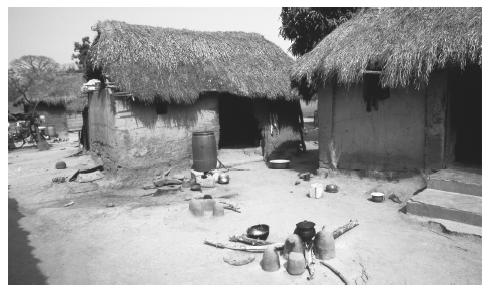Most traditional homes are build up out of mud and straw bricks, the roof is composed of thatched straw or corrugated metal. The Boule use rectangular structures, while the Senufo set their compounds in a circle around a courtyard. The artistic Dan use red and white clay to paint murals on their mud brick homes.
Most of Ivory Coast meals are made up from grains like rice, corn, millet, and tubers like yams and cassava. Families in most cases cook their food outdoors in ceramic or metal pots. Ivorian food is often spicy and it's also eaten with the hands. Well known dishes consists of rice with a pepper flavored peanut sauce, and fish. The most quintessential food of Ivoirians is the national dish futu. This dish consists of a thick heavy paste made of mashed plantains or yams eaten with a spicy sauce or stew made of fish or meat. The most popular treat in Ivory Coast is the masquis, it consists of braised chicken and fish with onions and tomatoes. The most favorite drink among villagers are palm wine and home brewed beer.
 One of Ivory Coast most famous festivals is the Festival of Mask, this festival takes place in villages of Man region every February. Also every March Ivorians celebrate a Carnival in Bouake, with food and festivities. Ivory Coast major Muslim holiday is the Ramadan, it's a month long celebration in witch everyone fasts(obtains from food) between sunrise and sunset in accordance with the fourth pillar of Islam, and then ends the fast with a big feast. Another Muslim holiday is the Eid al - Fitr, witch focuses in feasts, prayer, fellowship, and gift giving.
One of Ivory Coast most famous festivals is the Festival of Mask, this festival takes place in villages of Man region every February. Also every March Ivorians celebrate a Carnival in Bouake, with food and festivities. Ivory Coast major Muslim holiday is the Ramadan, it's a month long celebration in witch everyone fasts(obtains from food) between sunrise and sunset in accordance with the fourth pillar of Islam, and then ends the fast with a big feast. Another Muslim holiday is the Eid al - Fitr, witch focuses in feasts, prayer, fellowship, and gift giving.Each of the more than sixty ethnic group have different folk music traditions, most showing vocal polynophy especially the Baoule. The Senufo dance to the slow majestic rhythims of drums supported by xylophones. The Man forest wear mask showing horrifying faces, and they dance at a quick pace governed by the sound of drums and stilt-walkers.
The Zoblazo is a musical style from Abidjan, Ivory Coast, created in the early 1990's. It's a cosmopolitan popular dance music with simple up tempo rhythm and high tech instrumentation and contains a mixture of traditional dance rhythm from southern Ivory Coast. Zoblazo main exponent is Meiway.
The most popular styles in Ivory Coast are imported reggae from Jamaica and hip hop from United States. The country has notable musicians from both genres especially Alpha Blondy, whose brand of afro reggae became a national hit following his appearance on a TV show First Chance in 1983. Hip Hop had been popular in Ivory Coast since the 1990's. Notable Hip Hop musicians include All Mighty, Rudy Rudiction, M.C. Claver and Angelo.
Answer.com
Countries and their cultures


No comments:
Post a Comment